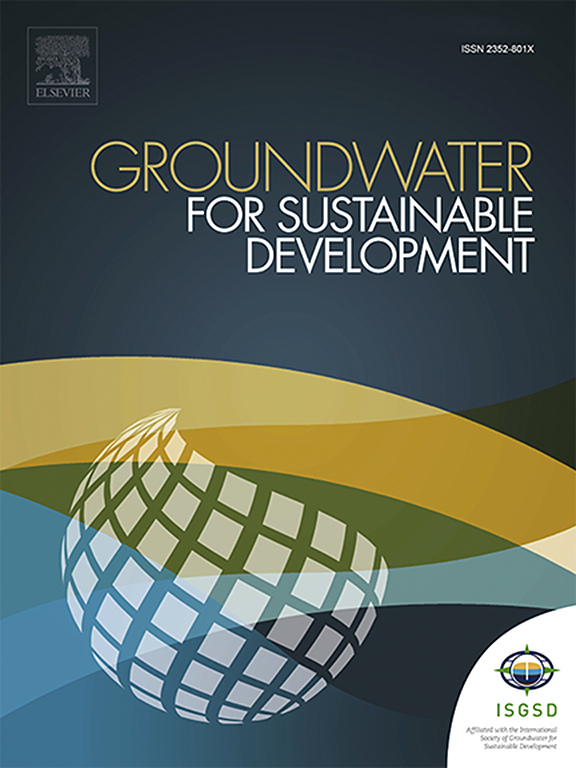利用纳米零价铁浸渍生物炭去除水中六价铬:通过Box-Behnken优化、动力学和等温线研究进行评估
IF 4.9
Q2 ENGINEERING, ENVIRONMENTAL
引用次数: 0
摘要
本研究旨在合成一种生态友好型生物炭负载纳米零价铁(nZVI),并在不同实验条件下评价其去除水生系统中六价铬[Cr(VI)]的效果。研究确定了吸附剂剂量(0.5 g L−1 ~ 2g L−1)、Cr(VI)浓度(20 mg L−1 ~ 100 mg L−1)和pH(2 ~ 8)等不同实验条件下对Cr(VI)去除率有较大影响的最佳条件。通过基于盒本肯设计(BBD)的响应面法(RSM)评估pH、初始铬浓度、复合剂量、温度和时间等重要变量的交互影响。与nZVI和生物炭相比,nZVI -生物炭复合材料表现出优异的去除效果,在pH为2时的去除效果最高。二阶多项式模型经方差分析验证,具有较高的决定系数(R2≥0.98)。Temkin和Sips模型与平衡数据吻合较好,表明是多分子层吸附,而准二级速率动力学表明化学吸附是限速步骤。此外,能谱分析(EDS)证实了吸附剂表面存在Cr(VI),傅里叶变换红外光谱(FTIR)证实了官能团在结合机制中的作用。本文章由计算机程序翻译,如有差异,请以英文原文为准。

Utilizing nano zero-valent iron impregnated biochar for removal of hexavalent chromium from water: An assessment through Box-Behnken optimization, kinetics, and isotherm studies
The current study focuses on synthesizing an ecofriendly biochar-supported nano zero-valent iron (nZVI) and evaluating its efficacy in removing hexavalent chromium [Cr(VI)] from aquatic systems under different experimental conditions. The study identifies the optimal conditions that have a substantial impact on Cr(VI) removal efficiency under different experimental sets including adsorbent dose (0.5 g L−1 to 2 g L−1), Cr(VI) concentration (20 mg L−1 to 100 mg L−1) and pH (2–8). The interactive impacts of important variables like pH, initial chromium concentration, composite doses, temperature, and time was assessed through response surface methodology (RSM) based on box-behnken design (BBD). The nZVI–biochar composite demonstrates superior performance compared to nZVI and biochar individually and highest removal efficiency was observed at pH 2. The second-order polynomial model for biosorption validated through ANOVA, have a high coefficient of determination (R2 ≥ 0.98). Temkin and Sips models fit well with equilibrium data, suggesting multi-molecular layer adsorption, while pseudo-second order rate kinetics indicated chemisorption as the rate-limiting step. Furthermore, energy dispersive spectroscopy (EDS) confirmed the presence of Cr(VI) on the adsorbent surface, and fourier transform infrared spectroscopy (FTIR) indicated the contribution of functional groups in the binding mechanism.
求助全文
通过发布文献求助,成功后即可免费获取论文全文。
去求助
来源期刊

Groundwater for Sustainable Development
Social Sciences-Geography, Planning and Development
CiteScore
11.50
自引率
10.20%
发文量
152
期刊介绍:
Groundwater for Sustainable Development is directed to different stakeholders and professionals, including government and non-governmental organizations, international funding agencies, universities, public water institutions, public health and other public/private sector professionals, and other relevant institutions. It is aimed at professionals, academics and students in the fields of disciplines such as: groundwater and its connection to surface hydrology and environment, soil sciences, engineering, ecology, microbiology, atmospheric sciences, analytical chemistry, hydro-engineering, water technology, environmental ethics, economics, public health, policy, as well as social sciences, legal disciplines, or any other area connected with water issues. The objectives of this journal are to facilitate: • The improvement of effective and sustainable management of water resources across the globe. • The improvement of human access to groundwater resources in adequate quantity and good quality. • The meeting of the increasing demand for drinking and irrigation water needed for food security to contribute to a social and economically sound human development. • The creation of a global inter- and multidisciplinary platform and forum to improve our understanding of groundwater resources and to advocate their effective and sustainable management and protection against contamination. • Interdisciplinary information exchange and to stimulate scientific research in the fields of groundwater related sciences and social and health sciences required to achieve the United Nations Millennium Development Goals for sustainable development.
 求助内容:
求助内容: 应助结果提醒方式:
应助结果提醒方式:


